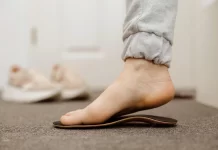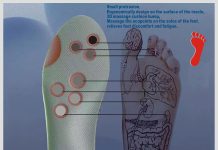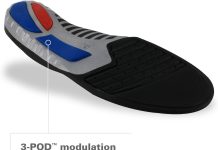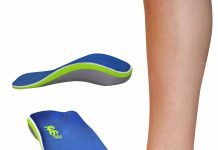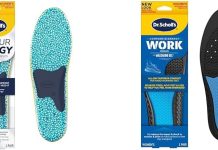In this article, we explore the significance of heel support in insoles. We delve into the various benefits that heel support provides, such as proper alignment and stability.
Focusing on this crucial aspect, we highlight how including heel support in insoles can significantly enhance comfort and alleviate discomfort in everyday activities and athletic pursuits.
Whether you’re a professional athlete or seeking relief from foot pain, understanding the importance of heel support in insoles is critical to maintaining optimal foot health.
What are insoles with heel support?
Insoles with heel support are specially designed inserts that provide added cushioning, stability, and support to the heel area of the foot. They are inserted into the shoes to improve comfort and relieve various foot conditions. These insoles are typically made from materials such as memory foam, gel, or foam rubber, and they offer targeted support to the heel while accommodating the foot’s natural shape.
Definition of insoles with heel support
Insoles with heel support refer to shoe inserts built with a specific focus on providing enhanced cushioning and stability to the heel area of the foot. They are designed to alleviate pressure on the heels and support various foot structures, such as the arch and the plantar fascia. These insoles are often recommended for individuals with foot conditions like plantar fasciitis, Achilles tendonitis, or heel spurs.
Types of insoles with heel support
Several types of insoles with heel support are available in the market, each catering to specific foot conditions and preferences. Memory foam insoles contour to the foot’s shape, providing custom support and cushioning. Gel insoles offer excellent shock absorption and cushioning. Arch support insoles provide additional support to the arch and heel. There are also orthotic insoles designed to alleviate pain and correct foot alignment. Choosing the right type that suits your needs and foot structure is essential.
Benefits of heel support insoles
Using insoles with heel support can offer a range of benefits for your feet and overall comfort. Here are some of the key advantages:
Improved shock absorption
Heel support insoles absorb the impact of walking or running, reducing the strain on your heels and joints. Providing additional cushioning can help prevent discomfort and potential injuries caused by repetitive impact.
Enhanced stability and balance
The added support and stability from heel support insoles can improve your balance and stability while walking or engaging in physical activities. They help distribute your weight evenly across the foot, reducing the risk of ankle sprains or other balance-related issues.
Reduced pressure on the heel
Heel support insoles relieve pressure on the heel, making them beneficial for individuals with conditions such as plantar fasciitis or heel spurs. Providing cushioning and support alleviates pain and allows for better weight distribution.
Prevention of injuries
Insoles with heel support can play a preventive role in reducing the risk of various foot and lower limb injuries. By absorbing shock and supporting the feet, they help minimize stress on the joints, ligaments, and tendons, decreasing the likelihood of overuse injuries.
Alleviation of foot pain
Insoles with heel support can relieve different types of foot pain, including plantar fasciitis, Achilles tendonitis, or heel spurs. They help distribute pressure more evenly and provide additional cushioning to ease pain and discomfort.
Common foot conditions that can benefit from heel support insoles
Insoles with heel support can benefit a wide range of foot conditions. Here are some common conditions that can benefit from using these insoles:
Plantar fasciitis
Plantar fasciitis is characterized by inflammation of the plantar fascia, a band of tissue connecting the heel to the toes. Heel support insoles can provide the necessary cushioning and arch support to alleviate pain and reduce strain on the plantar fascia.
Achilles tendonitis
Achilles tendonitis refers to the inflammation of the Achilles tendon, which connects the calf muscles to the heel bone. Heel support insoles can help distribute pressure and reduce strain on the Achilles tendon, providing relief from pain and promoting proper healing.
Heel spurs
Heel spurs are bony outgrowths that can develop on the underside of the heel bone. They can cause significant discomfort and pain. Heel support insoles can provide cushioning and support to reduce pressure on the heels, alleviating pain associated with heel spurs.
Flat feet
Flat feet, or fallen arches, occur when the arches of the feet collapse and touch the ground. Heel support insoles can help provide arch support and distribute weight more evenly, improving foot alignment and reducing strain on the feet and ankles.
High arches
Conversely, high arches can also benefit from heel support insoles. These insoles can cushion and support the heel, helping to alleviate pressure on the feet and ankles and providing stability.
Overpronation
Overpronation is when the foot rolls excessively inward during walking or running. Heel support insoles can help correct alignment and provide support, reducing the risk of overpronation-related injuries.
Supination
Supination, or underpronation, occurs when the foot rolls outward excessively during the gait cycle. Heel support insoles can provide stability and cushioning, offering support to the heel and reducing the risk of supination-related injuries.
Choosing the proper heel support insoles
When selecting heel support insoles, you must consider critical factors to find the fit and support for your feet. Here are some guidelines to follow:
Consider your foot type
Different foot types require different types of support. Determine if you have flat feet, high arches, or neutral arches, as this will help you narrow down the appropriate insole style for your needs.
Assess your specific needs.
Identify the specific foot condition or issue you are experiencing. For example, if you have plantar fasciitis, look for insoles with extra arch support and cushioning in the heel area.
Get professional advice
If you’re unsure which insoles to choose, it’s always a good idea to consult a healthcare professional or podiatrist. They can assess your feet, provide expert guidance, and recommend the most suitable insoles.
Evaluate cushioning and shock absorption.
Consider the level of cushioning and shock absorption provided by the insoles. Look for materials such as memory foam or gel that offer excellent shock absorption properties and maximum comfort.
Check arch support
Pay attention to the arch support provided by the insoles. Choose insoles that offer appropriate arch support for your foot type, whether you have flat feet, high arches, or neutral arches.
Consider material and breathability.
Choose insoles made from breathable materials that allow for proper airflow, reducing moisture and odor. Consider the material’s durability and how well it will hold up over time.
Test for proper fit
Try the insoles before purchasing to ensure they fit comfortably in your shoes. They should support the heel without feeling too tight or restricting movement. Ensure they don’t take up too much space in the shoe and allow your feet enough room to move naturally.
How to use heel support insoles effectively
To make the most of your heel support insoles, follow these tips for effective use:
Replace old or worn-out insoles regularly
Insoles can wear out over time due to regular use. Replace them as needed to ensure they continue to provide adequate support and cushioning.
Follow wearing instructions
Some insoles may have specific guidelines for use. Follow the manufacturer’s instructions regarding frequency of use or any recommended break-in periods.
Gradually adjust to wearing insoles.
If you’re new to using heel support insoles, it’s essential to gradually adjust to wearing them. Start by wearing them for short periods, then gradually increase the duration as your feet adapt.
Combine with proper footwear.
Pair your heel support insoles with shoes that provide proper support and stability. Look for shoes with a firm heel counter and adequate arch support for optimal results.
Use insoles for the intended activity.
Different insoles may be designed for specific activities, such as walking, running, or standing for long periods. Please choose the appropriate insoles for your intended activity to maximize their benefits.
Provide proper care and maintenance.
Clean and dry your insoles regularly to prevent odor and maintain their effectiveness. Follow any care instructions provided by the manufacturer.
Factors to consider when integrating heel support insoles into your footwear
When integrating heel support insoles into your footwear, keep the following factors in mind:
Compatibility with shoe size and style
Ensure that the insoles are compatible with your shoe size. Too large or small insoles can cause discomfort and affect your gait. Also, consider the shoe style you plan to wear with the insoles, as some styles may not have sufficient room to accommodate them.
Ensuring proper fit
The insoles should fit securely in your shoes without shifting or slipping during activity. This ensures they provide consistent support and alignment.
Allowing space for insoles
Consider the thickness of the insoles and the space available in your shoes. Ensure the shoes have enough room to accommodate the insoles without causing discomfort or affecting the fit.
Ensuring even weight distribution
Properly integrating the heel support insoles into your footwear can help ensure even weight distribution across the foot. This promotes proper alignment and reduces the risk of strain or injury.
Avoid excessive use of heel support.
While heel support insoles can be beneficial, striking a balance is essential. Excessive reliance on heel support insoles may cause the foot muscles to weaken over time. Make an effort to gradually reduce dependency on insoles when appropriate and engage in foot-strengthening exercises.
Potential drawbacks of heel support insoles
While heel support insoles can have numerous benefits, it’s essential to be aware of potential drawbacks:
Initial discomfort or adjustment period
Some individuals may experience initial discomfort or a brief adjustment period when using heel support insoles. This is normal as your feet adapt to the new support. Start by wearing them for short periods and gradually increase the duration.
Incompatibility with certain shoe styles
Certain shoe styles, such as sandals or open-toed shoes, may not be compatible with heel support insoles due to the lack of a closed heel or limited space for inserts. Consider the type of footwear you commonly wear and whether it can accommodate the insoles.
Possible decrease in sensitivity
Occasionally, heel support insoles may reduce sensitivity or tactile feedback from the ground. This can impact balance and fine motor skills in activities that require precise foot placement, such as dancing or specific sports.
Cost considerations
Heel support insoles can vary in price depending on the brand, material, and features. Consider your budget and the level of support required before making a purchase.
Tips for maintaining foot health in addition to using heel support insoles
Using heel support insoles is just one aspect of maintaining foot health. Here are some additional tips to keep your feet healthy and pain-free:
Maintain a healthy weight
Excess weight strains your feet and can contribute to pain or conditions like plantar fasciitis. Maintain a healthy weight to reduce stress on your feet and promote overall foot health.
Wear supportive shoes
Choose footwear that provides proper support, cushioning, and stability for your feet. Avoid wearing shoes that are too tight or do not offer adequate arch support.
Practice proper foot hygiene.
Keep your feet clean and dry to prevent fungal infections, such as athlete’s foot. Trim your toenails regularly and moisturize your feet to prevent dry skin or cracking.
Stretch and exercise regularly.
Perform regular foot exercises and stretches to strengthen the muscles, improve flexibility, and promote proper alignment. This can help prevent foot pain and maintain overall foot health.
Listen to your body.
Pay attention to any pain or discomfort in your feet. If you experience persistent foot pain or unusual symptoms, consult a healthcare professional or podiatrist for a proper diagnosis and treatment plan.
Conclusion
Insoles with heel support can benefit individuals dealing with foot pain, discomfort, or various foot conditions. By offering enhanced shock absorption, stability, and cushioning, these insoles can alleviate pain, reduce pressure on the heels, and prevent injuries.
Whether you have plantar fasciitis or Achilles tendonitis or want added comfort and support, heel support insoles can offer a practical solution. You can keep your feet happy, healthy, and pain-free by choosing the right insoles, using them effectively, and maintaining proper foot health practices.


